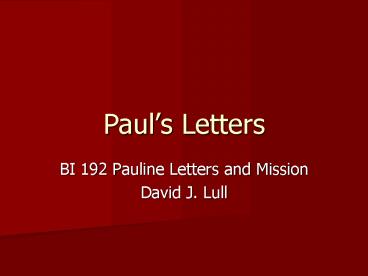Pauls Letters - PowerPoint PPT Presentation
1 / 18
Title:
Pauls Letters
Description:
Closing (e.g., Phil 4.21-23) Recapitulation. Final exhortations. Exchange of greetings. Benediction. Epistolary Styles and Rhetorical Elements ... – PowerPoint PPT presentation
Number of Views:88
Avg rating:3.0/5.0
Title: Pauls Letters
1
Pauls Letters
- BI 192 Pauline Letters and Mission
- David J. Lull
2
el Greco and Rembrandt
3
Types of Contents
4
Pauls Typical Letter Form
- Opening (e.g., Phil 1.1-2)
- Sender(s)
- Addressee(s)
- Salutation
- Thanksgiving (e.g., Phil 1.3-11)
- Body (e.g., Phil 1.12-4.20)
- Doctrines
- Exhortations (parenesis)
- Closing (e.g., Phil 4.21-23)
- Recapitulation
- Final exhortations
- Exchange of greetings
- Benediction
5
Epistolary Styles and Rhetorical Elements
- Ethos/character (Phil 1.3-11, 2.19-30, 3.18-19)
- Logos/proof (Phil 2.5-11, 3.2-4.1)
- Pathos/emotion (Phil 2.17-18)
- Defense (2 Cor 1.15-4.6, 7.2-16, Gal 1.10-2.21)
- Persuasion/dissuasion (Philippians 4)
- Consolation (Phil 1.12-26)
- Friendship (Phil 1.12-26)
- Blame (Phil 3.2, 18-19, Gal 6.12-13)
- Praise (Phil 2.19-30, 1 Corinthians 13)
6
Styles of Speeches and Rhetoric(see Aristotle,
On Rhetoric, 1.3.3-5)
7
Paul the Apostle(Gorman pp. 56-65)
- Apostle (Rom 1.1, 5, 1 Cor 1.1, 9.1, 15.7-11, 2
Cor 1.1, Gal 1.1, 1 Thess 2.7 Col 1.1, Eph 1.1,
Pastorals) - Slave (Rom 1.1, Tit 1.1)
8
Letters as Personal Presence
- 2 Cor 10.11
9
Contextual-Pastoral Theology and Community
Formation(Gorman pp. 76-78)
- Occasion-context-situation
- One-sided dialogue
- Public letters (1 Thess 5.27, Col 4.16)
- Examples of community formation
- 1 Corinthians
- Galatians
- Philippians
- 1 Thessalonians
- Phlm 1-2
10
Stories Behind and Within Letters(Gorman pp.
75-76)
- Gods Story
- Pauls Story
- The Addressees Story
11
Collection of the Letters(Gorman pp. 91-96)
- Occasional/contextual universal
- 1 Clement (ca. 96 CE)
- 2 Pet 3.16 (early 2nd century CE)
- Irenaeus (ca. 200 CE)
12
P 46 (ca. 200 CE)RomansHebrews1 2
CorinthiansEphesiansGalatiansPhilippiansColoss
ians1 Thessalonians
13
Muratorian Canon, ca. 200 CE(http//www.earlychri
stianwritings.com/muratorian.html)
- Letters to churches
- 1 2 Corinthians
- Ephesians
- Philippians
- Colossians
- Galatians
- 1 2 Thessalonians
- Romans
- Letters to individuals
- Philemon
- Titus
- 1 2 Timothy
- Forgeries (to further the heresy of Marcion)
- Laodiceans (cf. Col 4.16 also see 2 Thess 2.2)
- Alexandrians (Marcions revision of Ephesians)
14
Order of the Letters(Gorman pp. 91-96)
- Letters to churches
- Rom
- 1 2 Cor
- Gal
- Eph
- Phil
- Col
- 1 2 Thess
- Letters to individuals
- 1 2 Tim
- Tit
- Phlm
15
Authorship and Authenticity (Gorman 87-89)
- Co-senders, secretaries (Rom 16.22 cf. 1 Cor
16.21, Gal 6.11, Phlm 19 also see Col 4.18, 2
Thess 3.17) - Language and style
- Content (e.g., eschatological perspectives)
- Situation (e.g., institutionalization)
16
The ConsensusPseudonomous/Deutero-Pauline
- 2 Thess (50)
- Col (60)
- Eph (70)
- 2 Tim (80)
- 1 Tim Tit (90)
17
Interpolations?
- Rom 13.1-7
- 1 Cor 14.33b-35/36
- 1 Thess 2.14-16
- Rom 7.25b
18
Historical and Theological Observations (Gorman
pp. 89-91)
- The last word has not been written.
- What if similarities between Phlm and Col (and 2
Tim and 1 Tim) were given greater weight? - Imitation was the sincerest form of flattery and
discipleship. - Tastes and biases enter in, and change.
- Inspiration is not pinned to authorship.
- All are part of the Christian canon/Bible
regardless of their authorship.































